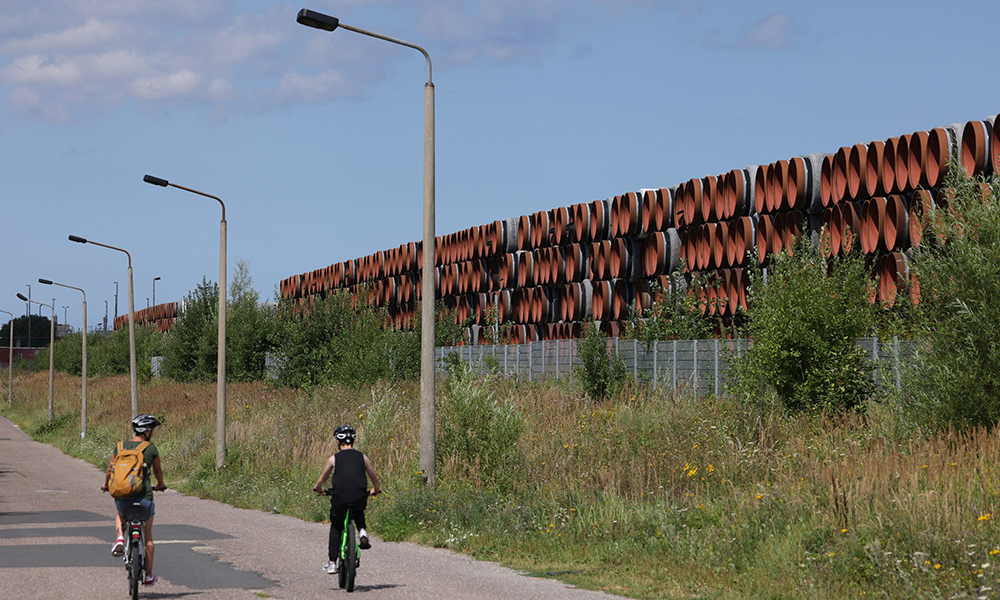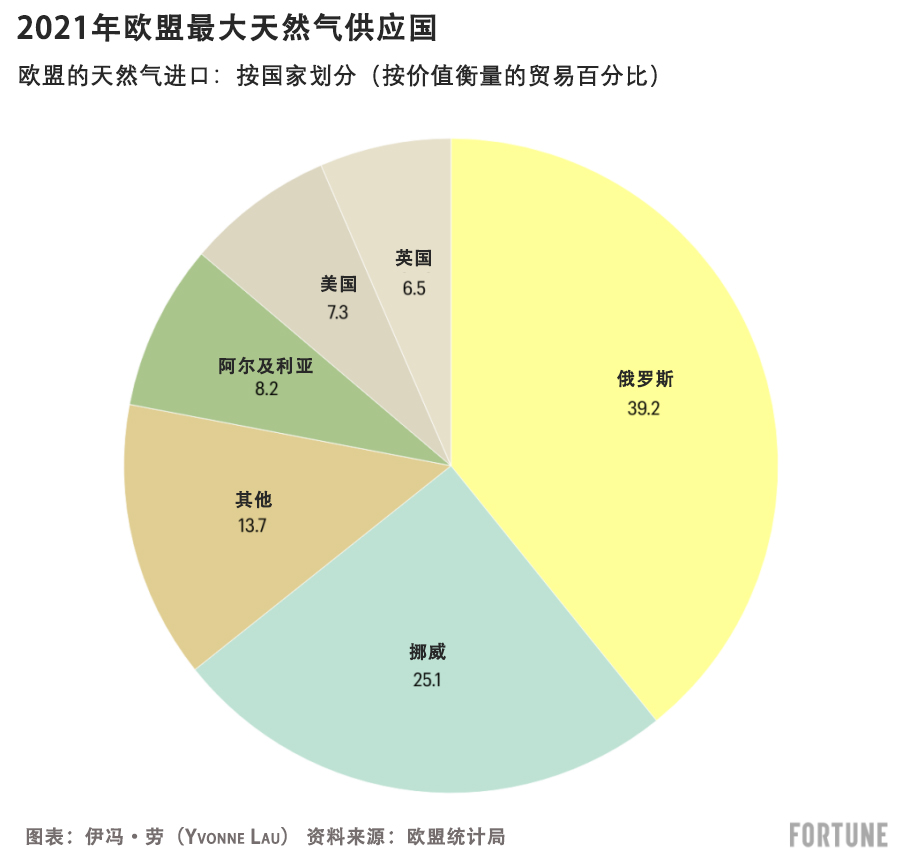
创纪录的热浪席卷欧洲,迫使人们打开空调,创纪录的热浪还引发野火并造成数百人死亡。国际能源署(International Energy Agency)向欧洲大陆发出严厉警告:立即削减天然气需求,否则将面临“漫长而艰难的冬天”。
但对欧洲来说,这可能说起来容易做起来难,因为酷热的天气迫使人们打开空调,而高温本身也让法国和德国等国无法提高核能力和定期获得燃料供应。
总部设在法国巴黎、负责确保全球能源安全的国际能源署在7月18日的一份报告中警告说,由于人们越来越担心俄罗斯完全切断对欧洲大陆的天然气供应,欧洲能源危机变得“异常危险”。
“随着冬天临近,我们对俄罗斯下一步可能采取的行动有了更清晰的认识。接下来的几个月将是至关重要的。我一直敦促[欧洲领导人]现在尽其所能,为漫长而艰难的冬天做准备。”国际能源署的执行干事法提赫·比罗尔在7月18日表示。
今年6月,俄罗斯最大的国有能源公司俄罗斯天然气工业股份公司(Gazprom)对欧洲的天然气供应减少了60%,理由是将俄罗斯天然气通过波罗的海的海底输送到德国的北溪1号 (Nord Stream 1)天然气管道需要进行维修。另一方面,欧盟委员会(European Commission)称,俄罗斯天然气工业股份公司的举动是俄罗斯政府的“勒索手段”,目的是考验即便面临无法为经济提供动力和实现家庭供暖的威胁,欧洲是否会因为俄乌冲突而坚持对俄罗斯实施制裁。
即使在努力为家庭实现降温、扑灭野火,并应对潜在的电力中断和因为高温而导致的火车轨道扭曲时,欧洲各国目前正忙着在冬季能源需求激增之前填充储气罐,欧盟的天然气储气库目前已满64%。国际能源署警告称,即使欧盟的天然气储存水平达到90%,一旦俄罗斯大规模切断天然气供应,各国仍将面临更高的天然气供应中断风险。
俄罗斯的天然气供应占欧洲约40%的天然气进口供应。去年,俄罗斯向欧洲大陆输送了1550亿立方米的天然气。

国际能源署表示,欧洲必须在未来几个月大幅削减天然气需求,以应对冬季的能源需求。
比罗尔说:“现在采取措施为过冬做准备要好得多,而不是让数百万人的福祉和欧洲经济受天气的摆布,或者……给[俄罗斯]总统弗拉基米尔·普京额外的筹码。”
行动计划
国际能源署写道:“需要立即采取的第一步”是大幅减少当前的天然气需求——从企业到家庭——以确保在冬季之前有足够的天然气储存水平。据该机构称,在接下来的三个月里,欧盟国家需要额外节省120亿立方米的天然气——足以填满130艘液化天然气(LNG)油轮。
为了避免严重的供应中断,欧盟已经采取行动确保替代能源供应国能够保证供应。7月18日,欧盟与阿塞拜疆签署了一项新协议,到2027年,阿塞拜疆每年至少供应200亿立方米天然气。但国际能源署警告称,依靠来自俄罗斯以外国家的天然气供应是不够的,因为这些供应根本无法填补由于俄罗斯停止供应而出现的巨大缺口。即使阿塞拜疆和挪威等国的天然气达到最大供应量,如果俄罗斯完全切断天然气供应,欧盟就仍然面临供应中断的巨大风险。
根据国际能源署,在可行的情况下,欧盟应该暂时加大使用煤炭和燃油发电,以及风能、太阳能甚至核能等可再生能源;并引入拍卖平台,允许工业天然气用户提供供应,以减少天然气需求。
德国经济和气候行动部的部长罗伯特·哈贝克当时表示,德国政府在今年6月做出了“痛苦……但十分必要”的决定,重新启用关闭的燃煤电厂以降低该国的天然气需求。该国的目标是在本十年末逐步淘汰煤炭发电。
欧盟各国还必须推进活动,鼓励家庭减少用电量,并制定夏季制冷标准和控制措施。
7月20日,欧盟委员会宣布各国将采取的额外紧急措施,以遏制天然气需求。
国际能源署写道:今年冬天可能会成为“对欧洲团结的历史性考验——不能失败——其影响远远超出能源领域”。(财富中文网)
译者:中慧言-王芳
创纪录的热浪席卷欧洲,迫使人们打开空调,创纪录的热浪还引发野火并造成数百人死亡。国际能源署(International Energy Agency)向欧洲大陆发出严厉警告:立即削减天然气需求,否则将面临“漫长而艰难的冬天”。
但对欧洲来说,这可能说起来容易做起来难,因为酷热的天气迫使人们打开空调,而高温本身也让法国和德国等国无法提高核能力和定期获得燃料供应。
总部设在法国巴黎、负责确保全球能源安全的国际能源署在7月18日的一份报告中警告说,由于人们越来越担心俄罗斯完全切断对欧洲大陆的天然气供应,欧洲能源危机变得“异常危险”。
“随着冬天临近,我们对俄罗斯下一步可能采取的行动有了更清晰的认识。接下来的几个月将是至关重要的。我一直敦促[欧洲领导人]现在尽其所能,为漫长而艰难的冬天做准备。”国际能源署的执行干事法提赫·比罗尔在7月18日表示。
今年6月,俄罗斯最大的国有能源公司俄罗斯天然气工业股份公司(Gazprom)对欧洲的天然气供应减少了60%,理由是将俄罗斯天然气通过波罗的海的海底输送到德国的北溪1号 (Nord Stream 1)天然气管道需要进行维修。另一方面,欧盟委员会(European Commission)称,俄罗斯天然气工业股份公司的举动是俄罗斯政府的“勒索手段”,目的是考验即便面临无法为经济提供动力和实现家庭供暖的威胁,欧洲是否会因为俄乌冲突而坚持对俄罗斯实施制裁。
即使在努力为家庭实现降温、扑灭野火,并应对潜在的电力中断和因为高温而导致的火车轨道扭曲时,欧洲各国目前正忙着在冬季能源需求激增之前填充储气罐,欧盟的天然气储气库目前已满64%。国际能源署警告称,即使欧盟的天然气储存水平达到90%,一旦俄罗斯大规模切断天然气供应,各国仍将面临更高的天然气供应中断风险。
俄罗斯的天然气供应占欧洲约40%的天然气进口供应。去年,俄罗斯向欧洲大陆输送了1550亿立方米的天然气。
国际能源署表示,欧洲必须在未来几个月大幅削减天然气需求,以应对冬季的能源需求。
比罗尔说:“现在采取措施为过冬做准备要好得多,而不是让数百万人的福祉和欧洲经济受天气的摆布,或者……给[俄罗斯]总统弗拉基米尔·普京额外的筹码。”
行动计划
国际能源署写道:“需要立即采取的第一步”是大幅减少当前的天然气需求——从企业到家庭——以确保在冬季之前有足够的天然气储存水平。据该机构称,在接下来的三个月里,欧盟国家需要额外节省120亿立方米的天然气——足以填满130艘液化天然气(LNG)油轮。
为了避免严重的供应中断,欧盟已经采取行动确保替代能源供应国能够保证供应。7月18日,欧盟与阿塞拜疆签署了一项新协议,到2027年,阿塞拜疆每年至少供应200亿立方米天然气。但国际能源署警告称,依靠来自俄罗斯以外国家的天然气供应是不够的,因为这些供应根本无法填补由于俄罗斯停止供应而出现的巨大缺口。即使阿塞拜疆和挪威等国的天然气达到最大供应量,如果俄罗斯完全切断天然气供应,欧盟就仍然面临供应中断的巨大风险。
根据国际能源署,在可行的情况下,欧盟应该暂时加大使用煤炭和燃油发电,以及风能、太阳能甚至核能等可再生能源;并引入拍卖平台,允许工业天然气用户提供供应,以减少天然气需求。
德国经济和气候行动部的部长罗伯特·哈贝克当时表示,德国政府在今年6月做出了“痛苦……但十分必要”的决定,重新启用关闭的燃煤电厂以降低该国的天然气需求。该国的目标是在本十年末逐步淘汰煤炭发电。
欧盟各国还必须推进活动,鼓励家庭减少用电量,并制定夏季制冷标准和控制措施。
7月20日,欧盟委员会宣布各国将采取的额外紧急措施,以遏制天然气需求。
国际能源署写道:今年冬天可能会成为“对欧洲团结的历史性考验——不能失败——其影响远远超出能源领域”。(财富中文网)
译者:中慧言-王芳
As record heatwaves scorch Europe, forcing people to turn up their air conditioning, triggering wildfires and killing hundreds, the International Energy Agency (IEA) has a stark warning for the continent: cut gas consumption immediately or face a "long, hard winter" ahead.
But that might be easier said than done for Europe as blistering temperatures are forcing people to crank up their air conditioners, and the heat itself has hurt the ability of countries like France and Germany to increase their nuclear capacity and to get their regular fuel deliveries.
In a July 18 report, the IEA—a Paris-based body that's charged with ensuring global energy security—warned that the global energy crisis is becoming "especially perilous" in Europe as fears mount over a complete cut-off of Russian gas supply to the continent.
“As we get closer to next winter, we are getting a clearer sense of what Russia may do next. The next few months will be critical. I have been urging [European leaders] to do all they can right now to prepare for a long, hard winter,” Fatih Birol, the IEA’s executive director, said on July18.
Gazprom, a Russian state-owned energy firm and the country's largest, curtailed gas supplies to Europe by 60% last month, citing repairs to the Nord Stream 1 pipeline that transports Russian gas to Germany beneath the Baltic Sea. The European Commission, on the other hand, described Gazprom's moves as an "instrument of blackmail" by the Kremlin to test whether Europe would stick to its sanctions against Russia over its war with Ukraine, even if it was threatened with the prospect of being unable to power its economy and heat its homes.
European nations are now scrambling to fill their gas storage tanks before winter's intense energy demands set in, even while they try to cool households, extinguish wildfires and deal with potential power disruptions and warped train tracks due to the heat. EU’s gas storage sites are currently 64% full. Even if the EU's gas storage levels reach 90%, countries still face a heightened risk for gas supply disruptions in the event of a wholesale Russian cut-off, the IEA warns.
Russia supplies around 40% of Europe's natural gas. Last year, the country delivered 155 billion cubic meters of gas to the continent.
The IEA says Europe must dramatically slash its gas intake over the next few months, to prepare for winter's energy demands.
“It’s much better to take steps now to prepare for winter, than to leave the well-being of millions of people and European economies [to] the mercy of the weather or... give extra leverage to [Russian] President Vladimir Putin," Birol said.
Action plan
The "first, immediate step" is to significantly reduce Europe's current gas consumption—from both businesses and households—to ensure adequate gas storage levels before winter, the IEA wrote. EU nations need to save an additional 12 billion cubic meters of gas—enough to fill 130 liquified natural gas (LNG) tankers—over the next three months, according to the agency.
To avoid a significant supply disruption, the EU has moved to secure alternative energy suppliers. On July 18, the EU inked a new deal with Azerbaijan for at least 20 billion cubic meters of gas per year by 2027. But the IEA cautions that it's not enough to rely on non-Russian sources of gas as these suppliers are "not available in the volumes required" to replace Russia's missing deliveries. Even if gas supplies from countries like Azerbaijan and Norway flow to Europe at maximum capacity, the EU still faces a substantial risk of supply interruptions if Russia cuts off its gas completely.
The EU should temporarily increase the use of coal and oil-fired power generation, and renewable sources like wind, solar and even nuclear power, where feasible; and introducing auction platforms that allow industrial gas users to offer their supply in order to reduce gas consumption, according to the IEA.
In June, the German government made the "bitter... but simply necessary" decision to reopen shuttered coal plants to lower the country's gas usage, Germany's economy and climate action minister Robert Habeck said at the time. The country was aiming to phase out coal power generation by the end of this decade.
EU countries also must advance campaigns to encourage households to reduce electricity consumption, and set cooling standards and controls during the summer.
On July 20, the European Commission announced additional urgent measures that countries will implement to curb gas consumption.
This winter could become a "historic test of European solidarity—one it cannot afford to fail—with implications far beyond the energy sector," the IEA wrote.






